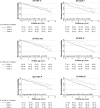Serum level of HDL particles are independently associated with long-term prognosis in patients with coronary artery disease: The GENES study
- PMID: 32424189
- PMCID: PMC7234989
- DOI: 10.1038/s41598-020-65100-2
Serum level of HDL particles are independently associated with long-term prognosis in patients with coronary artery disease: The GENES study
Abstract
HDL-Cholesterol (HDL-C) is not an accurate surrogate marker to measure the cardioprotective functions of HDL in coronary artery diseases (CAD) patients. Hence, measurement of other HDL-related parameters may have prognostic superiority over HDL-C. In this work, we examined the predictive value of HDL particles profile for long-term mortality in CAD patients and to compare its informative value to that of HDL-C and apoA-I. HDL particles profiles were measured by nuclear magnetic resonance (NMR) spectroscopy in 214 male participants with stable CAD (45-74 years). Median follow up was 12.5 years with a 36.4% mortality rate. Cardiovascular mortality accounted for 64.5%. Mean concentrations of total HDL particles (HDL-P), small-sized HDL (SHDL-P) and apoA-I were lower in deceased than in surviving patients whereas no difference was observed according to HDL-C and large HDL particles. All NMR-HDL measures were correlated between themselves and with other HDL markers (HDL-C, apoA-I and LpA-I). In a multivariate model adjusted for cardiovascular risk factors and bioclinical variables, HDL-P and SHDL-P displayed the strongest inverse association with all-cause and cardiovascular mortality. Weaker associations were recorded for apoA-I. Based on our results, we conclude that HDL particle profile measured by NMR spectroscopy should be considered to better stratify risk in population at high risk or in the setting of pharmacotherapy.
Conflict of interest statement
The authors declare no competing interests.
Figures


References
Publication types
MeSH terms
Substances
LinkOut - more resources
Full Text Sources
Other Literature Sources
Medical
Miscellaneous

